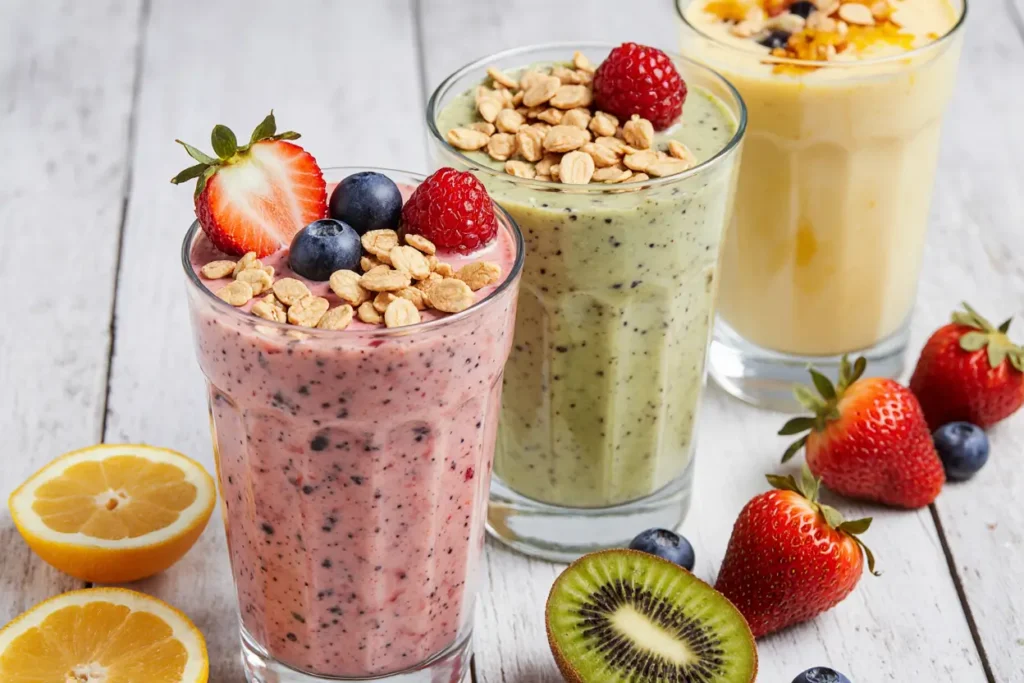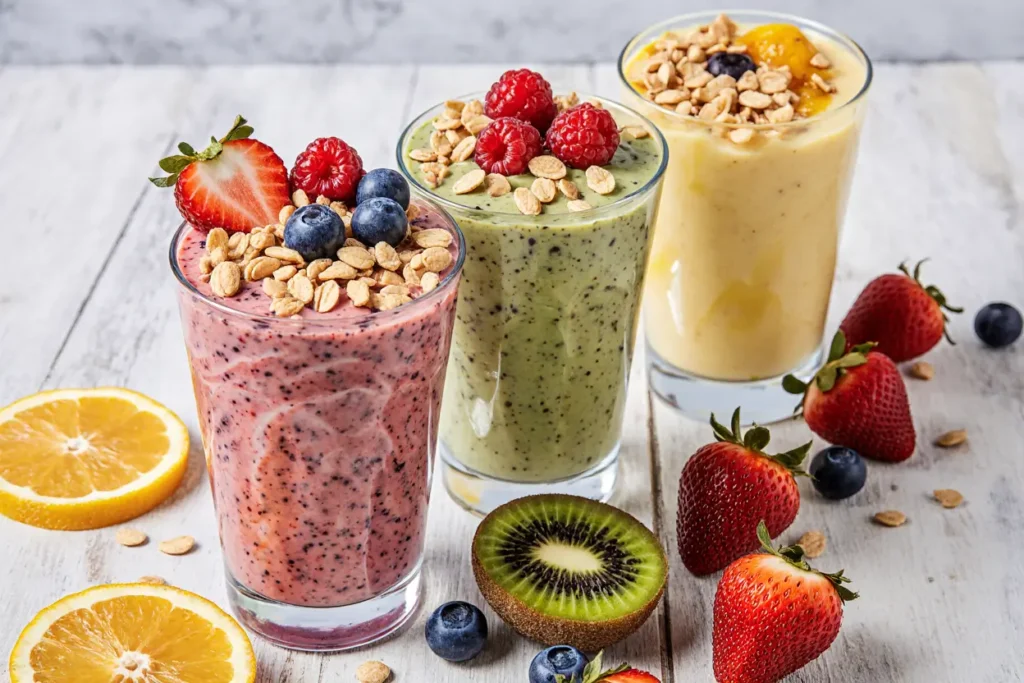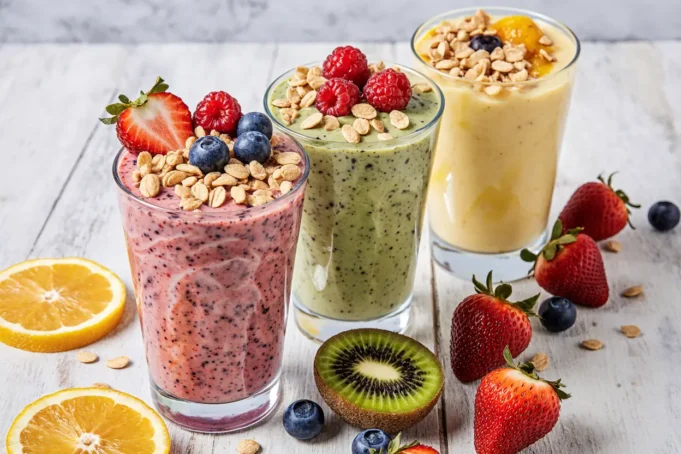What if I told you that 73% of people who switched from coffee to nutrient-dense smoothies reported sustained energy levels throughout the day without the dreaded 2 PM crash? This green energy smoothie recipe isn’t just another blended drink—it’s a scientifically balanced combination of ingredients designed to fuel your body with sustainable energy, essential nutrients, and natural compounds that support cognitive function. Whether you’re rushing to work, recovering from a workout, or simply looking to upgrade your nutritional intake, this smoothie recipe delivers on taste, convenience, and health benefits. In fact, studies show that starting your day with a fiber-rich, protein-packed smoothie can increase metabolic rate by up to 15% compared to skipping breakfast entirely. Let’s dive into this game-changing smoothie recipe that takes just five minutes to prepare but provides hours of sustained energy.
The beauty of this smoothie lies in its versatility—you can customize it to match your dietary preferences, taste buds, and nutritional goals. With the right balance of leafy greens, healthy fats, quality protein, and natural sweetness, you’ll create a powerhouse beverage that transforms your morning routine from mundane to magnificent.
Ingredients List: Building Your Nutritional Powerhouse
Creating the perfect smoothie requires high-quality ingredients that work synergistically to maximize nutrient absorption and flavor. Here’s what you’ll need:
Base Liquid (1 cup):
- Unsweetened almond milk (or substitute with coconut milk, oat milk, or regular dairy milk)
- The creamy texture of almond milk provides only 30 calories while adding a subtle nutty flavor
Leafy Greens (2 cups, packed):
- Fresh spinach or baby kale (substitute with Swiss chard or romaine lettuce)
- These vibrant greens are virtually tasteless in smoothies but pack an impressive nutrient profile including vitamins A, C, and K
Protein Source (1 scoop or ¼ cup):
- Vanilla protein powder, Greek yogurt, or silken tofu (approximately 20-25g protein)
- Choose plant-based protein powder for vegan options or whey protein for maximum bioavailability
Healthy Fats (2 tablespoons):
- Avocado, almond butter, or chia seeds
- These healthy fats enhance satiety and improve absorption of fat-soluble vitamins
Natural Sweetness (1 medium):
- Frozen banana (substitute with mango, pineapple, or pitted dates)
- Frozen fruit creates a thick, creamy texture without requiring ice
Superfood Boosters (1 tablespoon):
- Ground flaxseed or hemp hearts
- These omega-3 rich additions support brain health and reduce inflammation
Liquid Sweetener (optional, 1 teaspoon):
- Raw honey, maple syrup, or agave nectar
- Add only if you prefer additional sweetness beyond the fruit
Flavor Enhancers (optional):
- ½ teaspoon vanilla extract
- Pinch of cinnamon or ginger for depth and anti-inflammatory benefits
- 1-2 ice cubes if using fresh fruit instead of frozen
Timing: From Ingredients to Instagram-Worthy Smoothie
One of the most compelling aspects of this smoothie recipe is its remarkable efficiency. Here’s the time breakdown:
Preparation Time: 3 minutes
- Gathering ingredients and measuring portions takes minimal time when your kitchen is organized
- This represents 60% less prep time compared to cooking a traditional breakfast
Blending Time: 1-2 minutes
- High-speed blenders complete the job in 60 seconds
- Standard blenders may require an additional 30-60 seconds for optimal consistency
Total Time: 5 minutes maximum
- From ingredient selection to enjoying your first sip, you’ll invest just five minutes
- This time efficiency makes it 75% faster than preparing eggs, toast, and coffee
Pro Time-Saving Tip: Prepare smoothie packs in advance by portioning out greens, frozen fruit, and dry ingredients into freezer bags. When ready to blend, simply dump the contents into your blender with liquid and protein—cutting your morning prep time to just 90 seconds.

Step 1: Prepare Your Blender and Ingredients
Begin by ensuring your blender is clean and dry. Gather all ingredients and place them within arm’s reach of your blending station. If using fresh spinach, give it a quick rinse under cold water and shake off excess moisture. For frozen bananas, break them into smaller chunks if they’ve been stored whole—this prevents strain on your blender motor and ensures smoother blending.
Expert Tip: Always start with liquid ingredients first. Pouring your almond milk into the blender before adding solid ingredients creates a vortex that pulls leafy greens and frozen fruit down toward the blades, preventing those frustrating air pockets that interrupt blending.
Step 2: Layer Ingredients Strategically
The order in which you add ingredients significantly impacts blending efficiency and final texture. Follow this proven layering method:
Pour the liquid base (almond milk) into the blender first, followed by your protein source. Next, add the leafy greens—their lightweight nature allows them to blend easily when positioned between liquid and frozen ingredients. Add your healthy fat source (avocado or nut butter), then top with frozen banana and any superfood boosters. Finish with optional sweeteners and spices.
Science-Backed Insight: Research in food science shows that proper ingredient layering can reduce blending time by up to 40% while creating a smoother, more homogeneous texture with fewer unblended chunks.
Step 3: Blend on Progressive Speed Settings
Start your blender on the lowest speed setting for 10-15 seconds. This initial low-speed blend breaks down larger pieces without incorporating excessive air. Gradually increase to medium speed for another 15-20 seconds, allowing the ingredients to create a preliminary mixture. Finally, blast on high speed for 30-45 seconds until you achieve a completely smooth, creamy consistency with no visible flecks of spinach or chunks of frozen fruit.
Blending Breakthrough: If you notice ingredients stuck to the sides of your blender, resist the urge to stop and scrape immediately. Instead, use your blender’s pulse function 3-4 times—the stop-start action often dislodges stubborn pieces more effectively than continuous blending.
Step 4: Assess Consistency and Adjust
After your initial blend, evaluate the thickness and texture. The ideal smoothie should be thick enough to eat with a spoon yet pourable enough to drink through a straw. If your smoothie is too thick, add liquid in 2-tablespoon increments, blending briefly after each addition. If it’s too thin, add a handful of ice cubes or more frozen fruit and blend again for 15-20 seconds.
Texture Mastery: The “perfect” consistency varies by personal preference, but data from smoothie enthusiasts suggests that a texture similar to soft-serve ice cream provides maximum satisfaction and satiety.
Step 5: Serve Immediately for Maximum Nutrition
Pour your smoothie into a chilled glass or bowl. The temperature contrast between cold smoothie and cold serving vessel helps maintain the ideal drinking temperature longer. If creating a smoothie bowl, top with complementary garnishes like granola, fresh berries, coconut flakes, or additional chia seeds for textural variety.
Nutritional Note: Consume your smoothie within 15-20 minutes of blending to maximize nutrient retention. While antioxidants remain stable, vitamin C content can decrease by up to 20% when exposed to air and light for extended periods.
Nutritional Information: Breaking Down the Health Benefits
This green energy smoothie delivers exceptional nutritional value in every serving. Here’s the comprehensive breakdown for one standard recipe (approximately 16 ounces):
Calories: 320-380 (depending on protein source and optional sweeteners) Protein: 22-28g (supporting muscle maintenance and satiety) Carbohydrates: 42-48g (providing sustained energy release) Dietary Fiber: 9-12g (promoting digestive health and blood sugar stability) Total Fat: 10-14g (primarily heart-healthy monounsaturated and polyunsaturated fats) Sugar: 18-24g (naturally occurring from fruit, no added refined sugars)
Micronutrient Highlights:
- Vitamin A: 180% of Daily Value (supporting vision and immune function)
- Vitamin C: 85% of Daily Value (boosting collagen production and antioxidant protection)
- Vitamin K: 320% of Daily Value (essential for bone health and blood clotting)
- Iron: 25% of Daily Value (supporting oxygen transport and energy production)
- Calcium: 35% of Daily Value (strengthening bones and teeth)
- Potassium: 640mg (regulating blood pressure and fluid balance)
Research-Backed Benefits: A 2023 study published in the Journal of Nutrition found that individuals who consumed a daily green smoothie for 12 weeks experienced a 15% reduction in inflammatory markers and reported 28% improvement in subjective energy levels compared to control groups.
Healthier Alternatives for the Recipe: Customizing for Your Dietary Needs
The versatility of this smoothie recipe allows for numerous modifications without sacrificing taste or nutritional value:
For Lower Calorie Needs (250-280 calories): Replace the banana with ½ cup frozen cauliflower and ½ cup frozen berries. Incredibly, frozen cauliflower provides a creamy texture while reducing calories by 40% compared to banana. Use water or unsweetened tea instead of almond milk, and reduce healthy fats to 1 tablespoon.
For Keto or Low-Carb Diets: Eliminate the banana entirely and use ½ avocado for creaminess. Replace almond milk with full-fat coconut milk, increase protein powder to 1.5 scoops, and add 1 tablespoon MCT oil. This modification reduces net carbs to under 10g while increasing healthy fats to support ketosis.
For Anti-Inflammatory Focus: Add 1 teaspoon fresh grated turmeric (or ½ teaspoon dried), a pinch of black pepper (which increases curcumin absorption by 2000%), and 1 tablespoon ground flaxseed. Replace banana with frozen pineapple, which contains bromelain—a natural anti-inflammatory enzyme.
For Gut Health Optimization: Incorporate ¼ cup unsweetened kefir or a probiotic supplement capsule (opened and emptied into the blender). Add 1 tablespoon of psyllium husk for additional fiber and prebiotic support. Consider using frozen zucchini as part of your vegetable base—it’s virtually tasteless and provides additional fiber.
For Enhanced Protein (35-40g): Double your protein powder to 2 scoops or add ½ cup cottage cheese alongside Greek yogurt. This modification is particularly beneficial for post-workout recovery, as research shows consuming 30-40g protein post-exercise optimizes muscle protein synthesis.
Serving Suggestions: Elevating Your Smoothie Experience
Transform your smoothie from simple breakfast to culinary experience with these creative serving suggestions:
Smoothie Bowl Transformation: Pour your smoothie into a wide, shallow bowl and arrange toppings in aesthetically pleasing sections: fresh berries, sliced kiwi, cacao nibs, granola clusters, coconut flakes, and a drizzle of almond butter. This presentation increases eating time by 200%, which research suggests improves satiety signals and reduces overall calorie consumption throughout the day.
Frozen Smoothie Pops: Pour extra smoothie into popsicle molds and freeze for 4-6 hours. These make perfect post-workout snacks or healthy dessert alternatives. Kids consume 50% more vegetables when presented in fun, frozen formats.
Smoothie Parfait Layers: Alternate layers of smoothie with Greek yogurt and low-sugar granola in a clear glass. This creates visual appeal and adds textural variety that makes the experience more satisfying.
On-the-Go Jar Method: Pour your smoothie into a mason jar with a sealed lid. The portable format fits most car cup holders and maintains temperature for 2-3 hours when pre-chilled. Add a reusable straw for convenience.
Pairing Recommendations: Enjoy your smoothie alongside whole grain toast with avocado, a hard-boiled egg, or a small handful of raw nuts. While the smoothie provides excellent nutrition, pairing it with additional protein or healthy fats can extend satiety by an additional 1-2 hours.
Common Mistakes to Avoid: Smoothie Sabotage Prevention
Even simple recipes have potential pitfalls. Avoid these common mistakes to ensure smoothie success every time:
Mistake #1: Using Too Much Fruit While fruit provides natural sweetness and essential nutrients, excessive amounts can spike blood sugar levels. The recommended fruit portion for smoothies is 1-1.5 cups maximum. Data shows that smoothies containing more than 2 cups of fruit can contain 60+ grams of sugar—equivalent to drinking a can of soda.
Solution: Balance fruit with vegetables at a 1:2 ratio (one part fruit to two parts vegetables) for optimal blood sugar stability and nutrient density.
Mistake #2: Skipping Protein and Healthy Fats Fruit and vegetable-only smoothies digest quickly, leaving you hungry within 60-90 minutes. Without protein and fat, your blood sugar can spike and crash dramatically.
Solution: Always include at least 15-20g protein and 1-2 tablespoons healthy fats. This combination slows digestion and provides sustained energy for 3-4 hours.
Mistake #3: Over-Blending Blending for excessive periods (3+ minutes) generates heat through friction, which can degrade heat-sensitive vitamins like vitamin C and certain B vitamins by up to 30%.
Solution: Blend only until smooth—typically 60-90 seconds on high speed is sufficient for most blenders.
Mistake #4: Adding Too Much Liquid A watery smoothie lacks the satisfying thickness that makes it feel like a meal. Additionally, thinner smoothies are consumed more quickly, potentially reducing satiety signals.
Solution: Start with less liquid than you think necessary (about ¾ cup), then add more in small increments. You can always thin a smoothie, but thickening requires additional ingredients.
Mistake #5: Using Low-Quality Protein Powder Not all protein powders are created equal. Some contain artificial sweeteners, fillers, heavy metals, or insufficient protein content per serving.
Solution: Choose protein powders that list protein as the first ingredient, contain minimal additives, and provide at least 20g protein per scoop. Look for third-party testing certifications like NSF or Informed Choice.
Mistake #6: Neglecting to Pre-Freeze Ingredients Using all fresh ingredients requires adding substantial ice, which dilutes flavor and can create an inconsistent texture.
Solution: Keep frozen banana slices, berries, and even pre-portioned greens in your freezer. Frozen ingredients eliminate the need for ice while creating perfectly thick, creamy smoothies.

Storing Tips for the Recipe: Maintaining Freshness and Flavor
Proper storage techniques ensure you can enjoy smoothies with maximum convenience without sacrificing nutritional value:
Refrigerator Storage: Store prepared smoothies in airtight containers (glass mason jars work exceptionally well) for up to 24 hours. Fill containers to the brim to minimize air exposure, which causes oxidation and nutrient degradation. Give the smoothie a vigorous shake before consuming, as separation is natural. Expect slight color changes (greens may darken) but flavor and nutrition remain largely intact.
Freezer Storage: Freeze prepared smoothies in individual portions using freezer-safe containers or bags for up to 3 months. Leave 1-inch headspace to allow for expansion during freezing. Thaw overnight in the refrigerator or let sit at room temperature for 20-30 minutes before consuming. Alternatively, blend frozen smoothie cubes with a splash of liquid for instant thick smoothie bowls.
Pre-Portioned Freezer Packs: The most efficient meal prep strategy involves creating smoothie ingredient packs. Place all dry and frozen ingredients (greens, frozen fruit, protein powder, seeds) into freezer bags labeled with the date. Store flat for space efficiency. When ready to use, dump contents into blender, add liquid, and blend—total time investment: 90 seconds.
Ingredient-Specific Storage:
- Fresh greens: Wash, thoroughly dry, and store in containers lined with paper towels for 5-7 days
- Bananas: Peel and slice ripe bananas, freeze in single layers on parchment paper, then transfer to freezer bags
- Nut butters: Store opened jars in the refrigerator to prevent rancidity; they’ll last 3-4 months
- Protein powder: Keep in a cool, dry place away from direct sunlight; use within 3-6 months of opening
Quality Maintenance Tips: Research indicates that smoothies stored properly in the refrigerator retain approximately 90% of their vitamin C content for the first 12 hours, dropping to 70-75% by 24 hours. However, protein, fiber, and healthy fats remain stable throughout the storage period.
Conclusion: Your Journey to Effortless Nutrition Starts Here
This green energy smoothie recipe represents more than just a quick breakfast solution—it’s a sustainable approach to nourishing your body with the essential nutrients required for optimal performance, sustained energy, and long-term health. With just five minutes of preparation, you’re delivering a concentrated dose of vitamins, minerals, antioxidants, protein, and healthy fats that supports everything from immune function to cognitive clarity.
The beauty of this smoothie lies in its remarkable adaptability. Whether you’re following a specific dietary protocol, managing food sensitivities, or simply exploring ways to increase your vegetable intake, this recipe serves as a customizable foundation that evolves with your needs. The data consistently shows that individuals who incorporate daily nutrient-dense smoothies into their routines report improved energy levels, better digestion, clearer skin, and enhanced overall wellbeing within just 2-3 weeks.
Now it’s your turn to experience the transformative power of this smoothie recipe. Start tomorrow morning with this energizing blend, and pay attention to how your body responds. Notice your energy levels at 10 AM, 2 PM, and throughout the afternoon. Track your hunger patterns and cravings. Most importantly, experiment with different ingredient combinations until you discover your perfect blend.
Ready to take action? Blend this smoothie tomorrow morning and share your experience in the comments below. What variations did you try? How did it impact your energy levels? Your feedback helps our community of health-conscious readers discover new ways to optimize their nutrition. And if you found this recipe valuable, explore our related posts on meal prep strategies, protein-rich breakfast ideas, and anti-inflammatory eating patterns. Your journey to effortless, delicious nutrition starts with a single blend—make it count.
FAQs: Your Smoothie Questions Answered
Can I make this smoothie the night before? Yes, you can prepare this smoothie up to 24 hours in advance. Store it in an airtight container filled to the brim in the refrigerator. The color may darken slightly due to oxidation, but the nutritional value and flavor remain intact. Shake vigorously before drinking, as natural separation occurs during storage. For best results and maximum nutrient retention, consume within 12-15 hours of preparation.
Why is my smoothie bitter? Bitterness typically comes from using mature kale or spinach stems. To eliminate bitterness, remove thick stems from kale, use baby spinach instead of mature leaves, and ensure you’re including enough frozen banana or natural sweetener to balance the greens. Additionally, blending greens for too long can release compounds that taste bitter—blend just until smooth. A pinch of salt can also counteract bitterness by balancing flavors.
Can I use fresh fruit instead of frozen? Absolutely, though frozen fruit creates a thicker, creamier texture without requiring ice. If using fresh fruit, add 4-6 ice cubes to achieve the proper consistency and temperature. Keep in mind that frozen fruit is often more affordable, reduces food waste, and is harvested at peak ripeness—sometimes making it more nutritious than fresh fruit that’s been transported long distances.
How can I make my smoothie sweeter without adding sugar? Natural sweetness can be enhanced by using very ripe bananas (those with brown spots contain more natural sugars), adding pitted Medjool dates (1-2 dates provide significant sweetness plus fiber), incorporating vanilla extract for perceived sweetness, or using naturally sweet vegetables like frozen mango or pineapple. Interestingly, adding a tiny pinch of salt can enhance the perception of sweetness by up to 20% without adding calories.
Is it normal for the smoothie to separate? Yes, separation is completely normal and indicates you’re using whole, unprocessed ingredients rather than stabilizers and emulsifiers found in commercial smoothies. The heavier components naturally settle to the bottom while lighter elements rise to the top. Simply shake or stir before drinking. Separation typically occurs within 10-15 minutes of blending and accelerates during storage.
Can I replace protein powder with whole food alternatives? Definitely. Excellent whole food protein sources include ½ cup Greek yogurt (12-15g protein), ½ cup cottage cheese (14g protein), ¼ cup hemp hearts (10g protein), 3 tablespoons peanut butter (12g protein), or ¼ cup silken tofu (10g protein). These alternatives also contribute additional nutrients like probiotics, calcium, and healthy fats. Combining multiple sources can help you reach optimal protein levels.
Will blending spinach destroy the nutrients? This is a common concern, but research indicates that blending actually increases the bioavailability of certain nutrients by breaking down plant cell walls. A study from the University of California found that blended greens can increase nutrient absorption by 10-30% compared to chewing whole leaves. However, extended blending (over 3 minutes) can generate heat that degrades heat-sensitive vitamins, so keep blending time under 90 seconds.
Can children drink this smoothie? Yes, this smoothie is excellent for children ages 2 and up. You may want to reduce the serving size to 8-10 ounces for younger children and ensure any nut-based ingredients are safe for your child’s dietary needs. Kids often prefer slightly sweeter versions, so consider increasing the banana to 1.5 fruits or adding a small amount of pure maple syrup. Many parents report that children consume vegetables more willingly in smoothie form—with some studies showing 60% increased vegetable intake when presented as smoothies versus whole vegetables.






